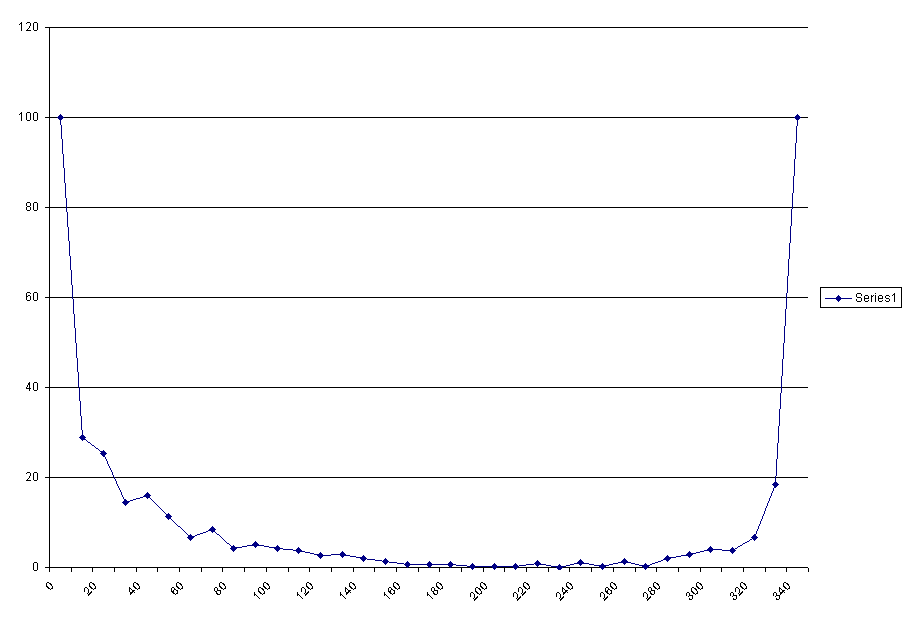
Course Number: MEMB 321
Day and Date experiment performed : 2000
Due Date:2000
Lecturer : ****
Statement of
Purpose/ Objective:
The objective of the experiment is to: -
·
Investigate the motion of a slotted link and to see if the
piston rod moves with simple harmonic motion.
Data,
Observation and Results:
|
Crank angle, q (degrees) |
Experimental Piston Rod Displacement, X (mm) |
Theoretical r(1-cos q) |
% error |
|
0 |
0 |
0 |
0 |
|
10 |
0 |
0.53173 |
100 |
|
20 |
1.5 |
2.11076 |
28.9355 |
|
30 |
3.5 |
4.68911 |
25.359 |
|
40 |
7 |
8.18844 |
14.5137 |
|
50 |
10.5 |
12.5024 |
16.0164 |
|
60 |
15.5 |
17.5 |
11.4286 |
|
70 |
21.5 |
23.0293 |
6.64065 |
|
80 |
26.5 |
28.9223 |
8.37524 |
|
90 |
33.5 |
35 |
4.28571 |
|
100 |
39 |
41.0777 |
5.05794 |
|
110 |
45 |
46.9707 |
4.1956 |
|
120 |
50.5 |
52.5 |
3.80952 |
|
130 |
56 |
57.4976 |
2.60457 |
|
140 |
60 |
61.8116 |
2.93077 |
|
150 |
64 |
65.3109 |
2.00715 |
|
160 |
67 |
67.8892 |
1.30984 |
|
170 |
69 |
69.4683 |
0.67408 |
|
180 |
69.5 |
70 |
0.71429 |
|
190 |
70 |
69.4683 |
0.76543 |
|
200 |
68 |
67.8892 |
0.16315 |
|
210 |
65.5 |
65.3109 |
0.28955 |
|
220 |
62 |
61.8116 |
0.30487 |
|
230 |
58 |
57.4976 |
0.87383 |
|
240 |
52.5 |
52.5 |
2.7E-14 |
|
250 |
47.5 |
46.9707 |
1.12686 |
|
260 |
41 |
41.0777 |
0.18912 |
|
270 |
35.5 |
35 |
1.42857 |
|
280 |
29 |
28.9223 |
0.2686 |
|
290 |
23.5 |
23.0293 |
2.04394 |
|
300 |
18 |
17.5 |
2.85714 |
|
310 |
13 |
12.5024 |
3.97976 |
|
320 |
8.5 |
8.18844 |
3.80482 |
|
330 |
5 |
4.68911 |
6.63002 |
|
340 |
2.5 |
2.11076 |
18.4408 |
|
350 |
0 |
0.53173 |
100 |
|
360 |
0 |
0 |
0 |
Sample
calculation:
Theoretical value:
For 60o
X = r(1-cos q)
= 35 * (1-cos 60o)
Experimental error:
% Error = (Experimental Value – Theoretical Value/Theoretical Value)*100
= (17.5-15.5/17.5)*100
= 11.4286
Theoretical equation:
For the first circle of R1:
x = 105 –70 – (35- r cos q)
So, x = 35-(35-35 *cos q)
= 35 – 35*cosq
= 35(1-rcosq)
x = r(1-r cosq)
Analysis and
Discussion:
From the experiment done, graphs of the experimental and theoretical value of piston rod displacement against the crank angle were plotted and it was found that the acceleration was increasing with an increase in crank angle. Up to some point, it reached its peak and then reducing the displacemet value through the same path of the increasing path.
The experiment can be considered successful since the error percentage between the experimental and theoretical value was not substantial. Some of the discrepancy of the measured value might be quite significant which may be due to parallax error and inconsistency of rotation of the crank.
The motion of the piston was found to be sinusoidal because the graph plotted showed that there were peak and valleys which occurred at the same distance in the rotation. The piston motion also exhibits a simple harmonic motion which is shown by an increasing displacement that is proportional with the crank angle at a fixed point. The increase in displacement indicates a variation in velocity thus the acceleration. The maximum acceleration occurred at 180o and 360o while the maximum velocity occurred at 90o and 270o. The maximum force on the drive pin occurred at the maximum velocity because it involves a centrifugal force.
Conclusion:
As a conclusion, it was found that the slotted link motion is a mechanism to perform a motion similar to that of a piston rod. The piston rod movement is of a simple harmonic motion because the point of movement acceleration’s is proportional to its displacement from a fixed point in its path. The force which is directed towards the crank center achieved its maximum value at the highest velocity that occurred at 90o and 270o.

